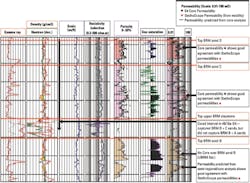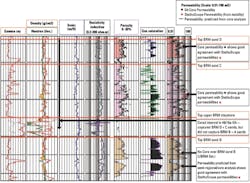Dual-gradient drilling promises to change the face of deepwater
Jim Redden
Contributing Editor
Nearly 10 years after a joint industry project certified it a field-proven technology, post-BOP dual-gradient drilling has been taken off the shelf and, if its proponents have their way, promises to number the days when constructing a deepwater well will require a long riser filled with pressure-inducing, but otherwise inactive, drilling fluid.
"This is game-changing technology and was quite the buzz in the late 1990s and early 2000s when it was first developed," says Ken Smith, dual-gradient drilling project implementation manager for Chevron North America. "Dual-gradient technology will allow us to remove the impact of water depth on well design."
Since late 2001, the game changer Smith refers to had been on the sidelines, but a confluence of economic and operational realities has since inspired the industry to take another look. What it sees now are rigs drilling more multi-well contracts at skyrocketing day rates that show no sign of declining anytime soon. It also sees those same rigs drilling ultra deepwater wells to greater depths with more complex geometries, creating ever-narrowing pore pressure and fracture gradients and higher equivalent circulating densities (ECD) that together add up to tighter casing tolerances. With deepwater wells now being drilled to 30,000 ft-plus (9,144 m), further exacerbating lost circulation and closing the safe drilling window even tighter, many say if the industry continues to rely on business as usual, many prospects could be left undrilled.
Dual-gradient drilling, its growing legion of supporters contend, is the only viable way for the industry to avoid hitting the proverbial wall in deepwater and ultra deepwater drilling. In fact, when discussing how it stacks up to conventional deepwater drilling, Smith and others leave the impression that wholesale use of the technology basically is a no-brainer.
"It's easier, safer, better for the environment, less expensive, the risks decrease, and the outcomes are more predictable," Smith says. "I think it will be the way we drill deepwater wells in the future."
Some have even gone so far as say that the further advancement of dual-gradient drilling means that, from a pure downhole design perspective, a well in the Campos basin someday could appear strikingly similar to one in West Texas or Oklahoma.
Going to next levelConsequently, for almost two years Chevron has taken the lead with a propriety initiative engineered to elevate a form of dual-gradient drilling from the bench to the playing field. If all goes well, the operator hopes to have the industry's first fully integrated and commercialized dual-gradient drilling system operating for real in the deepwater Gulf of Mexico by late next year. "We are proactively and radically changing the way we'll drill deepwater wells in the future," says Smith.
The effort has progressed to the point that Chevron earlier this year contracted the newbuildPacific Santa Ana drillship, with plans to deploy the new generation dual-gradient technology to drill within "Chevron's entire (GoM) portfolio out to 10,000 ft (3,048 m) of water," Smith says. Now under construction in South Korea, the Pacific Drilling rig is designed to drill to more than 35,000 ft (10,668 m) in up to 12,000 ft (3,658 m) of water.
"ThePacific Santa Ana drillship will provide Chevron and Pacific Drilling the opportunity to develop and deploy dual-gradient drilling technology during its activities in the deep waters of the GoM," Pacific Drilling said in a release announcing the contract.
Post-BOP dual-gradient technology is, as Smith says, a radical departure from the typical single-gradient drilling system that has been the norm for as long as anyone can remember. Quite simply, in a conventional deepwater drilling operation, the marine riser is filled with weighted drilling fluid that exerts unnecessary hydrostatic pressure on the wellbore, which severely impacts casing design and creates a host of downhole technical difficulties, not the least of which is well control. Conversely, in the dual-gradient mode, the riser is filled with seawater, which intrinsically induces less pressure, while the drilling fluid is confined to the wellbore, much like a shallow water or onshore well. In a nutshell, the once very thin drilling window becomes appreciably wider and safer to drill.
"With a dual-gradient profile, we fill the riser with seawater and everything below the mud line is filled with mud. So, essentially, what we are doing is paralleling the formation pressures and strengths that nature put in place," says Smith.
Basically, the technology takes over where the new generation riserless mud recovery system pioneered by Norway's AGR Subsea Inc. left off, in that it will be deployed further down the wellbore after the BOP has been latched and the riser installed. As the lead contractor for the Chevron project, AGR is looking to transfer to the lower intervals of deepwater wells, some of the technologies developed for its widely accepted riserless mud recovery system, which in late 2009 made its first entry into the deepwater GoM.
For the time being, Chevron and its subcontractors are tight-lipped on specific hardware and other technical modifications under development. While not getting into any details, Smith did say the integrated system now being advanced would be "a more robust and commercial form" of the prototype that was designed and successfully field-tested in the GoM. The prototype was developed as part of the five-year SubSea Mud Lift Drilling Joint Industry Project (JIP) launched in 1996 with project designer Hydril and participants BP, Chevron, Conoco, Texaco, Diamond Offshore, Global Marine, and Schlumberger. Hydril, which GE Oil and Gas acquired in 2008, designed the subsea pump deployed in the JIP field trial.
The primary components of the prototype, which was field proven in about 900 ft (274 m) of water on Texaco's Shasta prospect on Green Canyon block 136 in August 2001, are a subsea mud lift pump situated on the seabed and a subsea rotating diverter that provides the mechanical interface between the drilling fluid in the wellbore and the seawater in the riser. The rotating diverter also minimizes the influx of gas into the riser.
GE product manager, Bob Judge, who while working for what was then Hydril, was instrumental in the pump design for the JIP and is now involved in the Chevron project. Basically, he says the seawater-driven prototype developed as part of the JIP works like an internal combustion engine in an automobile.
"We have a cylinder that takes something in, combustion that will expel it out, and valves that control the timing of how all this happens. The difference is, we replace the cam shaft used in automobiles to operate the valves with a hydraulic system. Consequently, we can control the timing of the valves electronically. We can open and close them whenever we want."
All began up topProponents of dual-gradient drilling, or DGD, say all you have to do is look at the typical method of drilling a deepwater well today to realize there has to be a better way. Of course, that better way begins in the top hole, where the standard practice is to drill riserless to the predetermined first casing point, using seawater-based drilling fluid that is simply discarded on the seafloor. While "pump and dump" has been engrained in industry lexicon since not long after the first offshore well was drilled off Summerland Beach in California, operators employ it reluctantly and only because they had no other choice. While weighted drilling fluid using seawater as its core is environmentally benign, its properties leave much to be desired. With its inadequate rheological profile, a seawater-based drilling fluid simply is ill-equipped to tackle the shallow flows and other hazards of the top hole, forcing operators to set numerous casing strings to maintain wellbore stability. What is more, constructing a top hole with an open-ended circulating system requires a tremendous volume of drilling fluid that never will be recovered, raising myriad logistical and economic ramifications, that are especially profound considering deepwater wells are moving farther from shore and in more remote areas.
Enter AGR and its patented riserless mud recovery system. Primarily known for its subsea pumping systems, AGR developed the concept that includes, among other innovations, the use of a subsea mud pump and a mud return line to circulate the weighted drilling fluid and cuttings from the seafloor and back to the rig for drilling the critical top hole section of subsea wells.
Terry Scanlon, AGR senior vice president, cites a long list of reasons the AGR riserless drilling technology is far superior to traditional pump and dump. For one, since no seafloor discharge takes place and the spent mud is returned, operators have the luxury of running more highly engineered fluid systems to contend with the shallow flows and other hazards and wellbore stability issues of the top hole intervals. This improved quality of the top hole section can also lead to deeper setting depths for the initial casing strings, which may mean that fewer strings have to be installed overall.
He adds the closed-loop mud recovery system now has been used successfully in more than 100 wells worldwide. Early on, the wells comprised the top holes in relatively shallow water in Norway, the Caspian Sea, and elsewhere. In 2008, the technology made its way into the deepwater when dual pump modules were installed as part of a riserless mud recovery package used in a Shell well off Malaysia that was drilled in 5,000 ft (1,524 m) of water. In late December, the riserless mud recovery made its debut in the GoM where it was deployed in Mississippi Canyon on theDiscoverer Americas drillship to drill the top hole of the Statoil Krakatoa well in 2,060 ft (620 m) of water.
"This was exactly the kind of opportunity we were looking for on our first well in the GoM," Scanlon says. "By addressing the top-hole instability and the shallow water flow and shallow gas flow concerns, we were able to establish our game-changing technology and services capability on these difficult wells."
Statoil says that along with the obvious economic and operational benefits, the method also delivers environmental rewards.
"The (RMR) system allowed us to circulate the mud, consequently reducing the total mud consumption and discharge to the sea to a quarter of the amount typically used with conventional methods," says Tore Grønås, Statoil drilling superintendent for theDiscovererAmericas drillship. "The cost of mud itself and the transportation of it to the drillship are significantly reduced. In addition, this technology allows us to push the drilling depth deeper for the shallow casing string, which again reduces the overall drilling time per well."
AGR is now building on this expertise and is in the process of applying subsea mud pumping techniques to the post-BOP sections of the wellbore. This technology and know-how is being developed on the Chevron DGD project. The use of this technology, post-BOP, will allow Chevron and others improved drilling parameters in tight pore pressure/fracture gradient hole sections, possibly leading to larger hole sections and fewer casing strings on very deep wells, like many of the Lower Tertiary wells being drilled in the GoM, according to AGR, which is managing the design, manufacture, verification testing, and rig fit-up of the Chevron system under development
"The knowledge and expertise we are bringing to the (Chevron) project, now through the hardware phase, will further enhance our position as a technology and deepwater operations leader in pre-BOP and now post-BOP life-of-well applications," says Scanlon.
Putting mud in its rightful placeWhile GE's Judge says riserless mud recovery "fundamentally" is the same as post-BOP dual-gradient drilling in that both include a pump on the seabed, that is where the similarities end. With a conventional well design, once the BOP is latched, the influences of pressure raise a host of complications, including a number of well control issues. Many of those complications began and end with the enormous volume of mud in the riser. Generally, it is assumed that every 1,000 ft (305 m) of marine riser has a capacity of 400 bbl of drilling fluid, so it does not take a mathematician to ascertain that the volume of inactive mud in a well drilled in 10,000 ft (3,048 m) of water is mind boggling. This drilling fluid comprises the majority of the total fluid system while providing no benefit to the active drilling process. However, since the density of drilling fluid is much greater than that of seawater, the enormous volume in the riser increases the hydrostatic pressure at the wellhead. In addition, the cold temperatures of deepwater are especially detrimental to the rheological properties of mud in the riser. By taking drilling fluid out of the riser and into the wellbore and replacing it with seawater, the hydrostatic head at the seafloor is created by the seawater in the riser and the surrounding pressure at the mudline.
Judge says a dual-gradient drilling system behaves much like a managed pressure drilling (MPD) operation.
"The unique feature is that it can be used to control pressure in the well, allowing us to do some things in terms of detecting influxes and stopping them that were not possible before. The main thing is we want a constant pressure profile on the annulus with no crazy pulsations coming out of the pump."
He adds a great deal of the original development work centered on the network of valves, in particular the design of a mechanism capable of handling large cuttings without fouling the works.
"The first thing we had to do was actuate the valves with a hydraulic system to ensure big chunks (of cuttings) would not keep it open and, since it was designed to be subsea for a long time, sealing also was a big issue. We combined elastomer seals with floating metal floats and, essentially, made it self-sealing."
Smith says the prototype Judge and the others developed as part of the JIP definitely is technically sound and that the work Chevron spearheads is designed to take it to the next level.
"We are very confident in this technology. The nice thing about the JIP was that virtually every surprise we ran into was a positive surprise," adds Smith, who while with Conoco also served as project manager of the SubSea Mud Lift Drilling JIP.
"In conventional deepwater drilling, the water depth complicates well design, leading to the need to run a lot of casing strings. We have gotten extremely clever about working with the consequential very close tolerances, but this also leads to a lot of challenges like lost circulation and poor cement jobs. What dual gradient allows us to do and what we proved in the JIP is that we can completely remove the impact of water depth on well design. Therefore, if a well is in 10 ft (3 m) of water or 10, 000 ft (3,048 m) of water, it does not matter. From a pressure standpoint, we can design it exactly the same way," he adds.
Judge agrees that the JIP left few, if any, unanswered technical questions. "There were no technical issues that remained unsolved after the JIP. I think everybody bought into the idea that the technology works."
Timing is rightIf the technology is so beneficial, why has it essentially been mothballed for the better part of a decade? It's all a matter of timing, its staunchest advocates say, pointing out that the cost of the system admittedly is not for the economic faint-of-heart and at the time, it simply was not cost-effective.
"What killed us before is that the mob and demob cost of this kit is fairly high," says Judge. "If you put it on a rig that is not built for it, you have to modify the rig, bring the kit on, and then take if off. When we finished this project in 2001, rigs were getting 12- to 18-month contracts, meaning they might drill two to three wells. Also, day rates were comparatively lower than they are today. So, there simply was not a great deal of economic incentive. Now, we have much higher day rates and extended contracts, so I believe operators are looking at it and saying I can apply this cost over a multi-well program. Now, the economics look attractive."
Smith agrees and also concedes that operators with limited deepwater assets to drill may not find the technology financially feasible.
"Chevron has a substantial deepwater portfolio – a requirement for deploying this technology, as the investment in capital and people is otherwise too great. We didn't have that portfolio in 2001, when the JIP was completed," he says.
At the end of the day, Smith says the approaching first ever commercial application of a dual-gradient drilling system will represent the dismantling of one more technical wall.
"We're drillers and we're very good at running into a limit, finding our way around it, and then pushing that limit back. We are nearing the limit of accessing deepwater resources with conventional drilling method. Now is the time to try dual-gradient drilling, which is something fundamentally new."
More Offshore Issue Articles
Offshore Articles Archives
View Oil and Gas Articles on PennEnergy.com



